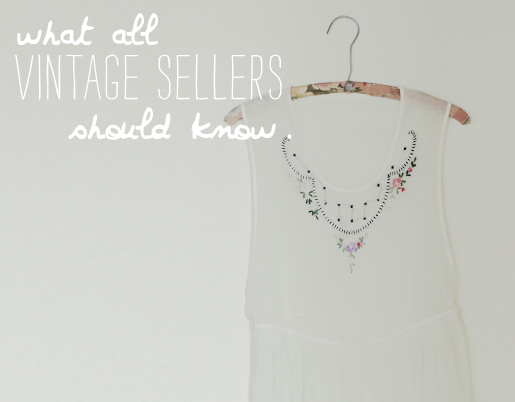
DISCLAIMER: This post wasn’t written to be a stab at any vintage sellers out there and it really isn’t intended to stir things up. My intention was to propose a conversational topic that people in my blogging community could chit chat about…because we’re all friends and share similar interests, right?? (this might be a lengthy post)

Actually two articles got me think. Read through them and I’d love for you to share your thoughts.
What All Vintage Clothing Sellers Should Know (an eBay Review)
Far too often new vintage clothing sellers enter into the vintage board with questions about how to sell and in particularly how to source vintage items. It’s not the questions that are unfortunate, it’s the replies that never cease to amaze me. Most responders politely reply that it’s a secret, many years of sourcing and building contacts and no one in their right mind would divulge their secrets to potential competition. Many others are not nearly so polite.
If you were to lurk on the boards long enough you’d see, as I have, that these questions are repeated like clockwork every few months. This guide is to dispel that myth and will probably annoy many vintage sellers but it’s necessary. It’s not my goal to annoy anyone, but it’s counterproductive to not educate potential vintage sellers. Every day mass produced copies of once rare vintage items are rolling onto docks across the world. Vintage sellers need to be educated about what they are selling or the entire market suffers. Buyers lose trust in the very term vintage and before you know it, selling vintage for a living becomes less and less a viable option.
Just about everyone wears clothes so finding vintage is far from a mystery. All it takes is knowledge, a willingness to learn from your mistakes and an outgoing personality helps. A vicious rumor has started in the vintage world, propagated on fashionista blogs, that vintage sellers simply head to the local Goodwill store, buys mounds of great clothes and jack up the price on eBay. They’ve made it sound simple, like anyone can just go and grab a handful of dress and make $2,000+ a month selling clothes from their living room.
Far too many potential sellers believe this and jump right in head first, last few dollars in hand, hoping this will be the way they finally make money on eBay. Yet another reason why the market is slowly collapsing. JUST BECAUSE A DRESS IS OLD DOESN’T MEAN IT’S VINTAGE!!!
Keep Reading this beauty–>

Why do I care? Why did I post this?
I’m a lover of most things old (I like to called them previously loved) and my collection of previously owned items is constantly growing. I value my collection because each piece was hunted down over a period of time. My knowledge of what makes something “vintage” is evolving and I’m learning little nuggets of information from all of you. Sometime in the near future I hope to own my own online business where I can extend my love for vintage/old items into the digital space and share my love with my readers. Before I take that leap I thought it was important to be knowledgeable about what classifies something and in turn, what kind of price tag you can put on something.
I thought this article was perfect in stating the facts. Having a vintage store on etsy is becoming a growing trend and I think a lot of people are jumping in without being educated. I would love the value of vintage to withstand the current trends, so we all need to be aware of what are treasures are really worth.
Here’s what I really want to know:
Where are vintage sellers sourcing their vintage? And how are vintage sellers determining the value of their product (price of product)?
I know I’m not going to get a single person talking about where they get their vintage items. There is a secrecy attached to this business. Its a no boys allowed type of thing. So if you’re brave. Spill the beans and educate us. True vintage sourcing takes LOTS time. I hear sellers of true vintage say they been pounding the pavements for years looking for the next best item. Curious what everyone has to say.
Alright, I’m signing off and leaving the “forum” open. Speak your mind and lets talk vintage/old pretty things!!!
I also thought this would be the perfect time to mention that I’ve got a lot of great vintage blogs in my Daily Reads link above. Check out those lovely ladies and buy their gorgeous products from their shops! (who cares if it’s real vintage or not)


